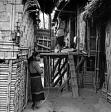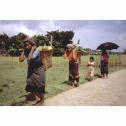|
Bangladesh is noted for the ethnic homogeneity
of its population. Over 98 percent
of the people are Bengalis,
predominantly Bangla-speaking
peoples. People speaking Arabic,
Persian, and Turkic languages also
have contributed to the ethnic
characteristics of the region.
Bangladesh's indigenous population
consisted of
 897,828
persons, just over 1 percent of the
total population, at the time of the
1981 census. They lived primarily in
the Chittagong Hills and in the
regions of Mymensingh, Sylhet, and
Rajshahi. The majority of the tribal
population (778,425) lived in rural
settings, where many practiced
shifting cultivation. Most tribal
people were of SinoTibetan descent
and had distinctive Mongoloid
features. They differed in their
social organization, marriage
customs, birth and death rites,
food, and other social customs from
the people of the rest of the
country. They spoke Tibeto-Burman
languages. In the mid-1980s, the
percentage distribution of tribal
population by religion was Hindu 24,
Buddhist 44, Christian 13, and
others 19. 897,828
persons, just over 1 percent of the
total population, at the time of the
1981 census. They lived primarily in
the Chittagong Hills and in the
regions of Mymensingh, Sylhet, and
Rajshahi. The majority of the tribal
population (778,425) lived in rural
settings, where many practiced
shifting cultivation. Most tribal
people were of SinoTibetan descent
and had distinctive Mongoloid
features. They differed in their
social organization, marriage
customs, birth and death rites,
food, and other social customs from
the people of the rest of the
country. They spoke Tibeto-Burman
languages. In the mid-1980s, the
percentage distribution of tribal
population by religion was Hindu 24,
Buddhist 44, Christian 13, and
others 19.
The four largest tribes were the
Chakmas, Marmas (or Maghs), Tipperas
(or Tipras), and Mros (or Moorangs).
The tribes tended to intermingle and
could be distinguished from one
another more by
 differences
in their dialect, dress, and customs
than by tribal cohesion. Only the
Chakmas and Marmas displayed formal
tribal organization, although all
groups contained distinct clans. By
far the largest tribe, the Chakmas
were of mixed origin but reflected
more Bengali influence than any
other tribe. Unlike the other
tribes, the Chakmas and Marmas
generally lived in the highland
valleys. Most Chakmas were
Buddhists, but some practiced
Hinduism or animism. differences
in their dialect, dress, and customs
than by tribal cohesion. Only the
Chakmas and Marmas displayed formal
tribal organization, although all
groups contained distinct clans. By
far the largest tribe, the Chakmas
were of mixed origin but reflected
more Bengali influence than any
other tribe. Unlike the other
tribes, the Chakmas and Marmas
generally lived in the highland
valleys. Most Chakmas were
Buddhists, but some practiced
Hinduism or animism.
Of Burmese ancestry, the Marmas
regarded Burma as the center of
their cultural life. Members of the
Marma tribe disliked the more widely
used term Maghs, which had come to
mean pirates. Although several
religions, including Islam, were
represented among the Marmas, nearly
all of the Marmas were Buddhists.
The Tipperas were nearly all Hindus
and accounted for virtually the
entire Hindu population of the
Chittagong Hills. They had migrated
gradually from the northern
Chittagong Hills. The northern
Tipperas were influenced by Bengali
culture. A small southern section
known as the Mrungs showed
considerably less Bengali influence.
The Mros, considered the original
inhabitants of the Chittagong Hills,
lived on hilltops and often
fortified their villages. They had
no written language of their own,
but some could read the Burmese and
Bangla scripts. Most of them claimed
to be Buddhists, but their religious
practices were largely animistic.
Tribal groups in other parts of the
country included Santals in Rajshahi
and Dinajpur, and Khasis, Garos, and
Khajons in Mymensingh and Sylhet
regions. Primarily poor peasants,
these people all belonged to groups
in the adjoining tribal areas of
India. |